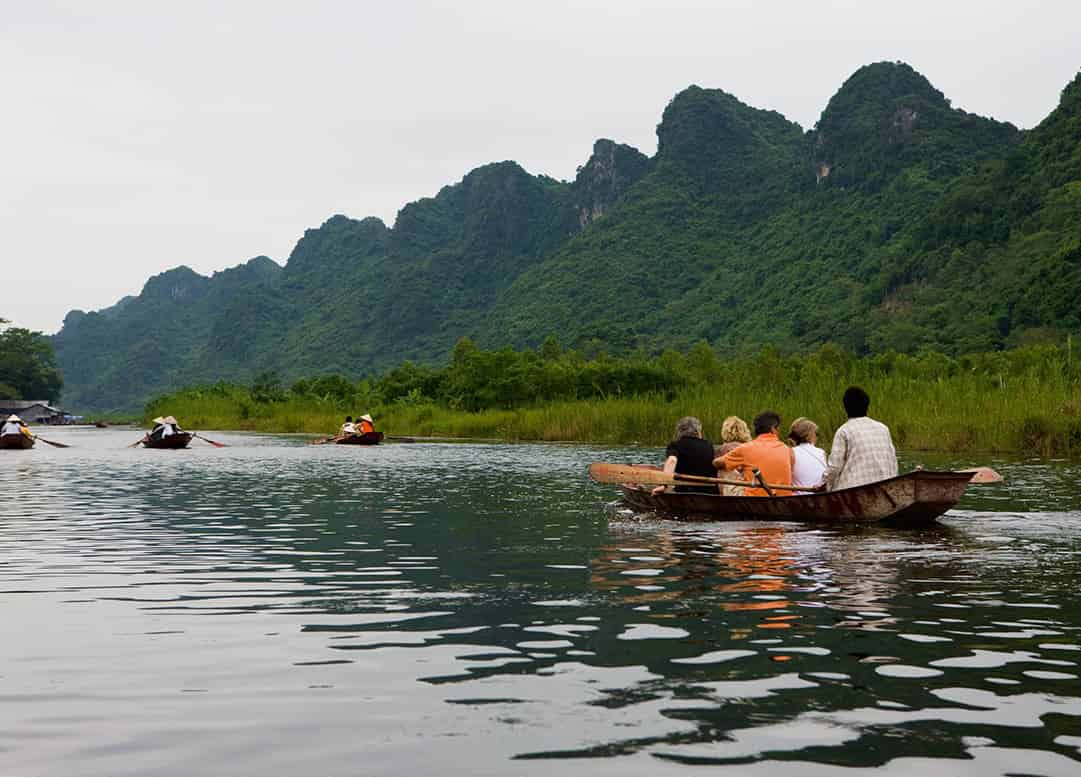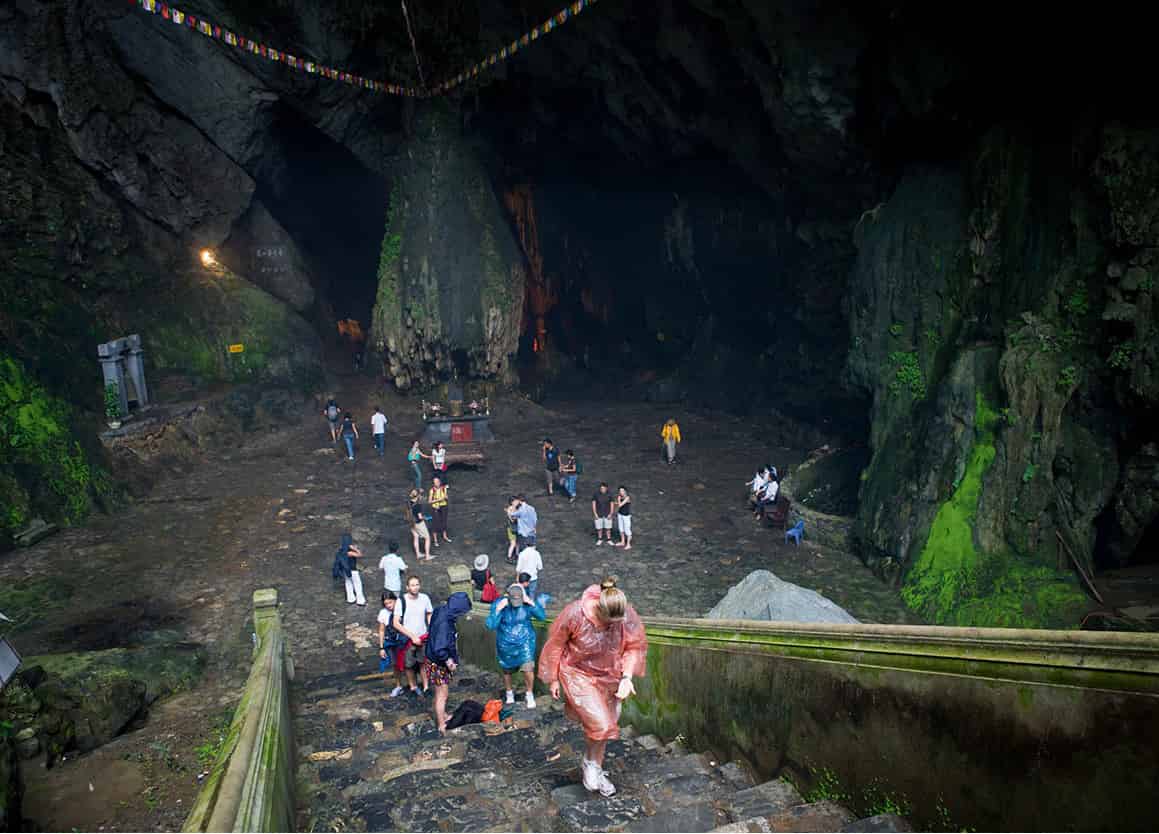DISTANCE: A 120km (74-mile) return drive southwest of Hanoi, followed by a 3-hour return boat ride, and finally a 4km (2.5-mile) return hike.
TIME: A full day
START/END: Yen Vi Village Boat Pier on the Yen River
POINTS TO NOTE: Don’t make this trip during weekends and festivals, in order to avoid crowds. Identical organised tours, sold by every hotel and ticket office in Hanoi, are the easiest way to reach the Perfume Pagoda, though this eliminates the option of visiting other temples or grottoes in the area. The route requires considerable walking up steep inclines. Children and the elderly especially may wish to use the optional gondola instead.
The site of the oddly misnamed Perfume Pagoda (Chua Huong; daily 7.30am–6pm; charge) comprises a group of temples covering an area of 30 sq km (11.5 sq miles). Built into the limestone cliffs of the ‘Ancient Vestiges of Perfume Grotto’ (Dong Huong Tich), otherwise known as the Perfume Mountains, the earliest temples date from the 15th century. By the early 20th century there were over 100. This area was the site for some bitter uprisings against the French colonialists and as a result, several temples were destroyed during the late 1940s. Fortunately, the area retains much of its natural splendour and is regarded as one of the most beautiful spots in Vietnam.
During the first two months after Tet (roughly February/March or March/April depending on the lunar calendar), the Perfume Pagoda can get very crowded with pilgrims, making for a frustrating (or alternatively, highly interesting) experience. The walk up the mountain is steep and can be quite tough going, so wear sensible shoes and bring a bottle of water. In the summer, it can get very hot and sweaty. Boats have no cover, so wear sun protection. As there are no places to eat along the way, bring a picnic lunch if your tour package does not include one, plus a torch for the caves.

Boat ride on the Yen River to the Perfume Pagoda
Peter Stuckings/Apa Publications
The boat ride
The journey by road south from Hanoi brings you to riverside Yen Vi village 1 [map] , where you board a shallow metal-bottomed boat (there are no roads to the Perfume Pagoda). For many, the 90-minute boat trip along the wide, swiftly flowing Yen River is almost as worthwhile as visiting the pagoda itself. Here fishermen wade the crystal waters among floating graves of their ancestors. As the oarsman steers the boat along the river, relax and take in the mesmerising landscape of jagged limestone hills.
The mountain hike
Disembark from the boat at the base of the Huong Tich Mountains for your 1.5–2-hour hike. Thien Tru Temple 2 [map] or Heavenly Kitchen (a reference to a Vietnamese constellation, not the secular noodle stalls that cluster around it) reaches up the mountain ahead. Most groups will have lunch at the food stalls, see 1, here. From here, weary travellers can take the convenient cable car 3 [map] (cap treo; charge) or continue up the path to the right of the temple, which leads to the destination 2km (1.25 miles) away. On your return, you may wish to climb the stone staircase to the right of the path leading to the Tien Son Temple 4 [map] , where there are unusual stone musical instruments made from stalagmites.
After 10 minutes along the main path, you will see a shrine built over a spring. Legend has it that if you bathe in Giai Oan 5 [map] , your spirit will be purified and false charges against you cleared. Where the path thins and becomes a little steeper, you will see the shrine for the ‘Goddess of the Mountains’ 6 [map] (Cua Vong). Your destination lies just below the summit of this mountain.
Huong Tich Grotto
You will see the portal and 120 stone steps bedecked with Buddhist flags leading down to the smoky depths of Huong Tich Grotto 7 [map] . Chinese characters etched on the outside of the cave in 1770 declare this to be the ‘most beautiful grotto under the southern sky’. Romantically inclined Vietnamese compare the cave to a dragon’s mouth, with the steps leading into the cavern as its throat.
The huge stalagmites at the mouth of the cave bear curious names. The bulbous one in the centre is called the Rice Stack, while other stalagmites inside have been named the Mountain of the Teenage Goddess, Silkworms Chamber, Cocoons Rack and the Heap of Coins. The bell near the entrance dates from 1655 and is only beaten on ceremonial occasions.
Altars, incense and statues
As your eyes grow accustomed to the darkness you will see many altars and statues of deities twinkling with candlelight. The central one houses an important statue of Quan Am (Goddess of Mercy), the female personification of the Buddha. Her androgynous figure is swathed in a diaphanous fabric. According to folklore, the bodhisattva Avalokiteshvara transformed himself into the female deity Quan Am here, and the shrine is dedicated to her. Through the haze of incense smoke you will see women with offerings of fruit and incense. Many barren women come to pray for children from the goddess inside.

In Huong Tich Grotto
Peter Stuckings/Apa Publications
For many Vietnamese this is the most important religious area in the whole of Vietnam, and many devout Buddhists will try to visit the shrine at least once in their lives. It is said that the Buddha himself may have visited this area once, leaving his ‘perfumed footprint’, the first of many theories about the origins of the name ‘Perfume’.
Today, monks still conduct services on request. If you come across one, listen for the soothing pitter-patter of Buddhist drums keeping time with the sound of condensation droplets falling in the cave.
For your return journey, choose a nice spot on the boat to enjoy the full scenery that has inspired generations of Vietnamese poets and monks.
Food and drink
1 Food stalls
Located at the boat pier; daily B, L & D; $$
There are a dozen humble food stalls located at the boat landing on the base of Huong Tich Mountain. Usually a group lunch at a stall of the guide’s choosing is part of package tours. Food is local fare (mostly stir-fried vegetables and fried fish) with rice. Drinks cost extra.
